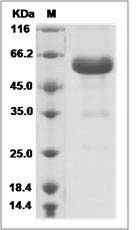-
Product Name
Human CD40/TNFRSF5 (Fc Tag) recombinant protein
- Documents
-
Description
CD40, also known as TNFRSF5, is a member of the TNF receptor superfamily which are single transmembrane-spanning glycoproteins. CD40 protein plays an essential role in mediating a broad variety of immune and inflammatory responses including T cell-dependent immunoglobulin class switching, memory B cell development, and germinal center formation. CD40 protein is expressed in B cells, dendritic cells, macrophages, endothelial cells, and several tumor cell lines. Defects in CD40 result in hyper-IgM immunodeficiency type 3 (HIGM3). In addition, CD40/CD40L interaction is found to be necessary for amyloid-beta-induced microglial activation, and thus is thought to be an early event in Alzheimer disease pathogenesis.
-
Protein name
Tumor necrosis factor receptor superfamily member 5
-
Protein short names
IGM; T-BAM; BP50; CD40; HIGM1; TNFRSF5; CDW40; IMD3; AI326936; P50; GP39; MGC9013; RP23-428M13.1; TRAP
-
Uniprot ID
Q6P2H9
-
Gene Name
CD40; TNFRSF5
-
Source/Expression Host
Human Cells
-
Expression Plasmid/cDNA
A DNA sequence encoding the human CD40 (NP_001241.1) (Met1-Arg193) was expressed with the Fc region of human IgG1 at the C-terminus.
-
Protein Species
Human
-
Molecular weight
The recombinant human CD40 consists 414 amino acids and predicts a molecular mass of 46.2 kDa.
-
Purity
> 90 % as determined by SDS-PAGE.
-
Activity
1. Measured by its binding ability in a functional ELISA.
2. Immobilized human CD40L-His (Cat:504291) at 10 μg/mL (100 μL/well) can bind Human CD40-Fc. The EC50 of Human CD40-Fc is 4-10 ng/mL. -
Validations

CD40 protein SDS-PAGE
Related Products / Services
Please note: All products are "FOR RESEARCH USE ONLY AND ARE NOT INTENDED FOR DIAGNOSTIC OR THERAPEUTIC USE"
